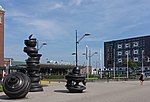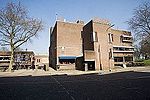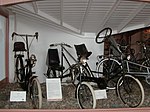Concertgebouw de Vereeniging
Art Deco architecture in the NetherlandsArt Nouveau architecture in the NetherlandsArt Nouveau theatresBuildings and structures in NijmegenConcert halls in the Netherlands ... and 2 more
Rijksmonuments in NijmegenTheatres completed in 1915

Concertgebouw de Vereeniging is a concert hall located in Nijmegen, Netherlands. The facility officially opened in 1915 and is built in a mixture of Art Nouveau and Art Deco styles. It has a capacity of 1,450 seats (or 1,800 standing people during pop concerts), and is renowned for its outstanding acoustics for orchestral music. Concertgebouw de Vereeniging is a designated Rijksmonument.
Excerpt from the Wikipedia article Concertgebouw de Vereeniging (License: CC BY-SA 3.0, Authors, Images).Concertgebouw de Vereeniging
Sint Annastraat, Nijmegen Nijmegen-Oost (Nijmegen)
Geographical coordinates (GPS) Address Nearby Places Show on map
Geographical coordinates (GPS)
| Latitude | Longitude |
|---|---|
| N 51.841388888889 ° | E 5.8608333333333 ° |
Address
Sint Annastraat 1A
6524 EA Nijmegen, Nijmegen-Oost (Nijmegen)
Gelderland, Netherlands
Open on Google Maps










